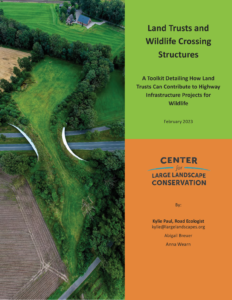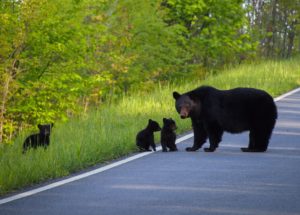 While roads in our communities help connect us, they can also divide us by fragmenting landscapes. But now is an exciting time to be involved in conservation and transportation ecology—or the study and reduction of impacts of roads and other linear infrastructure on wildlife and nature. There are now unprecedented funding opportunities and new state and federal policies to help implement projects to reduce wildlife-vehicle collisions and improve habitat connectivity. Land trusts can and do play a major role in these efforts.
While roads in our communities help connect us, they can also divide us by fragmenting landscapes. But now is an exciting time to be involved in conservation and transportation ecology—or the study and reduction of impacts of roads and other linear infrastructure on wildlife and nature. There are now unprecedented funding opportunities and new state and federal policies to help implement projects to reduce wildlife-vehicle collisions and improve habitat connectivity. Land trusts can and do play a major role in these efforts.
Maybe you work or volunteer for a land trust or conservation organization, and are interested in better understanding the critical role that land trusts play in increasing wildlife crossings across the nation. Or perhaps you are curious about how land trusts and landowners already work with transportation-related projects. A new resource was created with you in mind.
With help from numerous land trusts across the nation, the Center for Large Landscape Conservation has published a Land Trusts and Wildlife Crossing Structures toolkit. This new resource is a compilation of lessons learned and best practices in action by land trusts engaged in wildlife crossing structure projects.
“We developed this toolkit with the intention to inform and support land trusts and partners that are less familiar with connectivity and wildlife crossing efforts, and to offer further examples and lessons learned for those land trusts and partners already engaged in these types of projects,” says Kylie Paul, Road Ecologist with the Center for Large Landscape Conservation.
 This toolkit includes:
This toolkit includes:
- Exploration of the many ways land trusts can play a vital role in wildlife crossing projects
- Ideas for how land trusts can engage in projects
- Suggestions for how partners and agencies can work with land trusts
- Funding sources for wildlife crossings
- Public-private partnership opportunities
- Best practices, lessons learned, and examples from land trusts around the U.S.
- Numerous resources and links for further information
Land trust leaders that reviewed the document in advance said the following:
“I think this will be immensely useful for land trusts, and especially for those that aren’t yet involved in crossing structures or in partnerships with departments of transportation.”
“This is an excellent reference document for land trusts and partner groups!”
Want to help make this document even more helpful? If you have questions, comments, examples, best practices, or updates you think should be highlighted in the next version of the document, please contact Kylie Paul, Road Ecologist with the Center for Large Landscape Conservation at kylie@largelandscapes.org
Photo, top: Bridge over river serves as wildlife underpass – Adobe Stock
Photo, bottom: Mother black bear and cubs on a road – Adobe Stock



